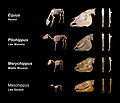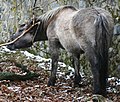Portal:Horses
The Horses PortalThe horse (Equus ferus caballus) is a domesticated, one-toed, hoofed mammal. It belongs to the taxonomic family Equidae and is one of two extant subspecies of Equus ferus. The horse has evolved over the past 45 to 55 million years from a small multi-toed creature, Eohippus, into the large, single-toed animal of today. Humans began domesticating horses around 4000 BCE, and their domestication is believed to have been widespread by 3000 BCE. Horses in the subspecies caballus are domesticated, although some domesticated populations live in the wild as feral horses. These feral populations are not true wild horses, which are horses that never have been domesticated. There is an extensive, specialized vocabulary used to describe equine-related concepts, covering everything from anatomy to life stages, size, colors, markings, breeds, locomotion, and behavior. Horses are adapted to run, allowing them to quickly escape predators, and possess a good sense of balance and a strong fight-or-flight response. Related to this need to flee from predators in the wild is an unusual trait: horses are able to sleep both standing up and lying down, with younger horses tending to sleep significantly more than adults. Female horses, called mares, carry their young for approximately 11 months and a young horse, called a foal, can stand and run shortly following birth. Most domesticated horses begin training under a saddle or in a harness between the ages of two and four. They reach full adult development by age five, and have an average lifespan of between 25 and 30 years. Horse breeds are loosely divided into three categories based on general temperament: spirited "hot bloods" with speed and endurance; "cold bloods", such as draft horses and some ponies, suitable for slow, heavy work; and "warmbloods", developed from crosses between hot bloods and cold bloods, often focusing on creating breeds for specific riding purposes, particularly in Europe. There are more than 300 breeds of horse in the world today, developed for many different uses. (Full article...) Entries here consist of Good and Featured articles, which meet a core set of high editorial standards.
EasyJet plc (styled as easyJet) is a British multinational low-cost airline group headquartered at London Luton Airport. It operates domestic and international scheduled services on 927 routes in more than 34 countries via its affiliate airlines EasyJet UK, EasyJet Switzerland, and EasyJet Europe. The company employs circa 13,000 people, based throughout Europe but mainly in the UK. EasyJet plc is listed on the London Stock Exchange and is a constituent of the FTSE 100 Index. Since its establishment in 1995, EasyJet has expanded through a combination of acquisitions, and base openings fuelled by consumer demand for low-cost air travel. The group, along with associate companies EasyJet UK, EasyJet Europe and EasyJet Switzerland, operates 321 aircraft. It has 29 bases across Europe, the largest being Gatwick. In 2022, the airline carried more than 69.7 million passengers, making it the second-largest budget airline in Europe by number of passengers carried, behind Ryanair. (Full article...) Selected image The Jutland is a breed of draft horse originating in Denmark. Latest updates
More did you know?
Related portalsEntries here consist of Good and Featured articles, which meet a core set of high editorial standards.
The Lusitano, also known as the Pure Blood Lusitano or PSL (Puro Sangue Lusitano), is a Portuguese horse breed. Horses were known to be present on the Iberian Peninsula as far back as 20,000 BC, and by 800 BC the region was renowned for its war horses. The fame of the horses from Lusitania goes back to the Roman Age, which attributed its speed to the influence of the West wind, who was considered capable of fertilizing the mares. When the Muslims invaded Iberia in 711 AD, they brought Arabian horses with them that were crossed with the native horses, developing a horse that became useful for war, dressage and bull fighting. The Portuguese horse was named the Lusitano, after the word Lusitania, the ancient Roman name for the region that modern Portugal occupies. There are four main breed lineages within the breed today, and characteristics differ slightly between each line. Lusitanos can be any solid color, although they are generally gray, bay or chestnut. Horses of the Alter Real strain are always brown. Members of the breed are of Baroque type, with convex facial profiles, heavy muscling, intelligent and willing natures, with agile and elevated movement. Originally bred for war, dressage and bullfighting, Lusitanos are still used today in the latter two. They have competed in several Olympics and World Equestrian Games as part of the Portuguese and Spanish dressage teams. They have also made a showing in driving competitions, with a Belgian team of Lusitanos winning multiple international titles. (Full article...) Did you know (auto-generated)
General imagesThe following are images from various horse-related articles on Wikipedia.
TopicsHorse • Pony • Asinus • Equus (genus) • Equidae • Zebra • Glossary of equestrian terms • List of horse breeds • Evolution of the horse • Domestication of the horse • Horse care • Stable • Horse training • Equestrianism • Horse tack • Saddle • Equine nutrition • Equine anatomy • Equine conformation • Equine coat color • Equine coat color genetics • Horse markings • Equine vision • Horse hoof • Horseshoe • Horse gait • Horse behavior • Horse breeding • Breed registry • Equine infectious anemia • Horse colic • Lameness • Laminitis • Horse slaughter • Horses in warfare • Arabian horse • Thoroughbred SubcategoriesNew articlesThis list was generated from these rules. Questions and feedback are always welcome! The search is being run daily with the most recent ~14 days of results. Note: Some articles may not be relevant to this project.
Rules | Match log | Results page (for watching) | Last updated: 2024-11-21 20:31 (UTC) Note: The list display can now be customized by each user. See List display personalization for details.
WikiProjectsAssociated WikimediaThe following Wikimedia Foundation sister projects provide more on this subject:
Discover Wikipedia using portals |




























































